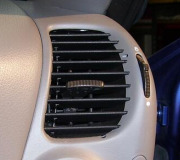This is impossible to tell. If there was nothing wrong with the amount of refrigerant in the system, adding more can allow liquid to slosh out of the evaporator in the dash and damage the compressor. (Compressors can't handle liquid; only vapor). If there is a leak, you might get some cold air until the refrigerant leaks out, then the low-pressure cutout switch will stop the compressor from running.
The only way to know how much refrigerant is in the system is to recover whatever is in there, then pump in the exact measured amount. Store-bought cans can't do that. The amount can only be measured with very expensive professional equipment. The only thing the little cans are good for is when you see the compressor cycling much too rapidly, and it has gotten slowly worse over a few years, you can be pretty sure it's low on charge. Usually you're save to add one pound since unlike home refrigerators, car systems need to be able to handle a slight over-charge to accommodate going up and down hills and over bumps.
The way to solve this is to add a little refrigerant, then check the entire system with an electronic leak detector. By law in most states, if the mechanic finds a leak, he is required to recover the refrigerant. The system can't be charged "just to get by for the weekend" or for the vacation. The leak must be fixed, THEN the system can be charged.
Here in Wisconsin, where the politicians have their hands in everything, there are people with nothing better to do than drive around the state with a car they know has a leak to see if they can catch someone willing to put refrigerant in without fixing the leak. I know they visited the dealership I worked for at least twice. Luckily the mechanic was following the rules. Funny thing is that law doesn't apply to do-it-yourselfers. They're only interested in getting shops in trouble.
Monday, August 8th, 2016 AT 9:00 PM



